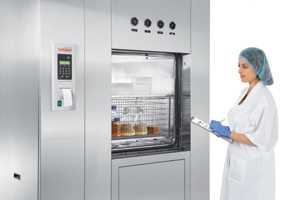Liquid Loads
Tuttnauer's laboratory sterilizers are designed for treating sensitve liquid loads. The autoclaves ensure that the correct sterilization temperature is attained when sterilization starts and that sterilization is initiated only when a temperature probe placed inside the medium reaches the preset threshold temperature. Tuttnauer offers advanced options that minimize the exposure time of liquids to high temperatures thereby preventing over cooking without compromising on sterilization results.
Fast Cooling
Accelerated chamber cooling is carefully controlled before chamber doors can be opended preventing a sudden drop in chamber pressure and temperature that can cause liquids to boil over. Tuttnauer’s accelerated cooling technology reduces the number of cycles per day and protects the load by minimizing its exposure to high temperatures. Rapid cooling typically reduces cooling time by as much as 75%.
Improved Air Removal
Effective steam prenetration of wrapped, porous and hollow loads is achieved due to air removal prior to sterilzation by an efficient vacuum pump. The post-vacuum drying phase ensures complete drying of porous loads and hollow instruments, and guarantees that even the most difficult loads will easily reach sterility assurance levels.
Advanced Sterilization Cycles
F0 Cycle
The "equivalent kill effect" F0 value is calculated during the heat-up phase of a sterilization cycle thereby reducing total media exposure time. Sterilization exposure time begins when the slowest-to-heat load temperature sensor within the autoclave has reached a predetermined set temperature.
Streaming Steam Cycle (105°C)
The streaming cycle is most commonly used for melting agar in Petri dishes. It is a low temperature sanitation cycle set at 105°C. Steam is allowed to enter the chamber and the fast exhaust valve is opened to allow steam to stream over the contents of the unit.
Disinfection/Isothermal Cycle (70-95°C)
A flexible low temperature cycle enables disinfection (“low” temperature isothermal). Temperature range settings are flexible within 70°C - 95°C range.


















